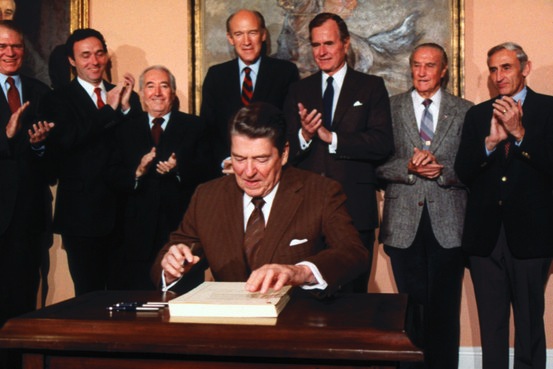
By Alex Gonzalez
The argument against the new immigration Bill is that it will be a repetition of the Reagan’s immigration Bill of 1986 that did not “secure the border.” And since the border was not “secure”, we now are faced with the conundrum of 11 million undocumented residents. And they are right. Reagan’s amnesty that legalized only 3 million of undocumented workers failed.
The 1986 immigration Bill and 2006 Fence Act legislation did not stop illegal immigration. And if the of the objective of the bill was to stop entirely the flow of unwanted workers, the plan indeed failed. But the reasons why the border was not “secure” under the 1986 Reagan bill are more directly associated with economic activity and Free Market principles than unsecured borders. For examples, any college Intro ECON class can teach you about the Push-and-Pull effect in a Free Market capitalist nation, which The U.S. has; and it is a very straightforward model.
The Push forces refer to conditions in the countries where immigrants come from, such as low incomes and restricted economic opportunities for children. Pull forces refer to opportunities in receiving countries, such as good earnings, jobs, and opportunities for children. Individuals migrate when the combination of push and pull forces make the expected gains from moving large enough to overcome the substantial difficulties of moving. And since 1990, the net gain from moving to the US has been very high to young Mexicans with modest skills and education. But it has been coincidentally this way because there has always been a Free Market capitalist system in the U.S. willing to hire these young low-skilled Mexican workers.
Under this “Push-and-Pull” forces, a capitalist economy cannot be regulated by flawed visa system. When the Free Market economy grows, fueled by demands for services and “job creators,” it pulls workers from any corner of the world when the native labor pool of workers is scarce.
But when a broken visa quota system denies the workers to industries, and the native laborer pool cannot be reliable since it is not big enough, entrepreneurs/businesses have two options: hire undocumented workers and risk penalties, or hold back any investment to create jobs. As a result, when no visas are available but the Market demand workers, industries are forced into a black market or perish due to the lack of workers. Hence, a broken visa quota system denies worker to” job creators” or turns entrepreneurs into “criminals” for knowingly breaking immigration laws.
In other words, a Capitalist Market cannot be regulated or held back by superficial flawed visa quotas–that would be a socialist society. And most likely Reagan’s economic advisers knew this very simple equation of Push-and-Pull and they opted to leave the border unguarded since Reagan was Free Market conservative. Therefore, the 1986 immigration reform failed to stop illegal immigration because it did not allow the federal government, or Immigration Department, to adjust the bill to the real number of workers required by labor demands. The Reagan bill legalized only 3 million while the U.S. economy demanded maybe an additional 3 million at the time and another 5 million to sustain the growth of 1990s and additional 5 million in the first decade of 2000. The CBO estimates that 73% of jobs performed by low-skilled immigrants are jobs native do not want to do, and undocumented workers are about 5% of national labor pool. See graph to see economic growth since the 80s when Reagan passed the Immigration bills and the two decades thereafter.
 The economic expansion of the 1990s was about 4% during and about 3% in the 2000s with a combined median of 3.5%; and it was mainly fueled by demand for services. However, only 5% of low-skilled immigrant workers here in the US have come “the legal way” because of superficial flawed visa quotas. Had we had a militarized the border with fences, as some have suggested, the Immigration Department could have provided only 5% of those 7 million of undocumented workers currently in the national labor pool; only 5% of low-skilled immigrants are granted visas to come the U.S. legally. Consequently, the lack of workers in the 1990s and 2000s has been forcing employers into clandestine black market since the economy has been booming but no visas have been allocated to sustain the economic boom. So the 1986 bill legalized 3 million. But it did create a superficial quota system that in reality could not have sustained the economic growth of the 1990s.
The economic expansion of the 1990s was about 4% during and about 3% in the 2000s with a combined median of 3.5%; and it was mainly fueled by demand for services. However, only 5% of low-skilled immigrant workers here in the US have come “the legal way” because of superficial flawed visa quotas. Had we had a militarized the border with fences, as some have suggested, the Immigration Department could have provided only 5% of those 7 million of undocumented workers currently in the national labor pool; only 5% of low-skilled immigrants are granted visas to come the U.S. legally. Consequently, the lack of workers in the 1990s and 2000s has been forcing employers into clandestine black market since the economy has been booming but no visas have been allocated to sustain the economic boom. So the 1986 bill legalized 3 million. But it did create a superficial quota system that in reality could not have sustained the economic growth of the 1990s.
Conservatives love to point out that Reagan created 20 million jobs during his two terms as President. So most likely Reagan knew that merely legalizing 3 million of immigrants would not be enough to sustain the expansion of the economy. But Reagan-a Free Market thinker who believed in Free Trade more than walls–assumed that the economy naturally will “pull” low-skilled immigrant workers from Mexico to supply shortage of native labor pool. So he left the door open at the border, no interior enforcement mechanisms and put unrealistic visa quotas to appease opponents to the bill. But this inconsistency led to the current problem.
Superficial quotas numbers were written to supply low-skilled workers, but it was only about 5% of required labor. Thus, in 1986, about 3 million were legalized but no mechanisms were allowed for adjusting the needs of the U.S. labor demands to supply more workers to sustain the growth of the economy in the 1990s and 2000s. In 2006 the Fence Act only funded fencing but did not fix the labor demands of the Market. Economy growth cannot wait for bureaucrats to regulate economic activity. And, regulating economic growth based in visa quotas would be quasi-socialism.
For Example, in Texas alone, 15% of the labor force is made of this subgroup of undocumented workers. These workers came to sustain its economic growth after the collapse of the state economy in the late 80s. If Texas had not received these workers in the 1990s, who came to Texas illegally, Texas could have not built the strong economy it currently has.
The U.S. economy requires a 5% unemployment to measure full-employment since a Free Market capitalist system requires at least 5% of people not working; either changing jobs or being trained for new technologies. If we look (see graphs) at the unemployment rates of the 1990s and 2000s–before the recession hit in 2009, the U.S. kept a healthy unemployment rate of about 5% ± rate for most of the two decades. And that happens to be the years when immigration from Mexico was at its highest before the 2008 “Great Recession” and just after Reagan left office. So the influx of immigration coincided with the natural growth of the economic and healthy employment levels left by Reagan in the 80s. Most likely Reagan knew of this economic trend, and the need for workers, but chose to put in place unrealistic low-skilled immigration quotas that did not reflect the needs of the economic; so he left the border open to supply the real number of workers required by the U.S. labor demands. So indeed Reagan set up flawed broken system that has created a population of 11 million of undocumented residents.
Adam Smith understood that while an efficient market would emerge from individual choices, those choices were framed by the political system in which they were made and…each dependent on the other for its existence. Smith argued that within the set of natural laws of competitions consumers’ sovereignty creates competition that leads to self-regulation. The market is self-regulating depending on consumer demand and supply, bought and sold. The market is the principal regulator and it replaces government regulations. An efficient market produces good consumers who want goods, and competition is the Invisible Hand or the moral sentiment naturally regulating man. Therefore, the free market and competition is king in regulating wages base on supply and demand, not Congress.
America Needs More Low-Skill Workers. Few Americans want careers cleaning hotel rooms or picking fruit, but low-skill immigrants want these jobs. Farms provide income to Americans employed not only in farming, but also in trucking and distribution. If farmers cannot find workers to pick fruit, as was the case in Washington State for the 2012 apple crop, products will be imported from countries with low-skill labor. It makes little sense for agricultural production to become uneconomic to avoid employing immigrants.
Free Market conservative Republicans should never be advocating for the suppression of entrepreneurial spirit, or hindering the markets through superficial visa quotas. A short supply of workers will prevent businesses or entrepreneurs from creating jobs. And punishing an entrepreneur for wanting to growth the economy when they hires workers when native workers are not available is un-American and anti-Capitalist. Reagan knew that the Spirit of Capitalism and the Free Market should never be replaced by fences and government bureaucrats.
Alex Gonzalez is a political Analyst and the Founder of Latino Pubic Policy Foundation (LPPF). He received a Bachelor’s Degree with emphasis in American politics, from San Francisco State University. comments to [email protected]





